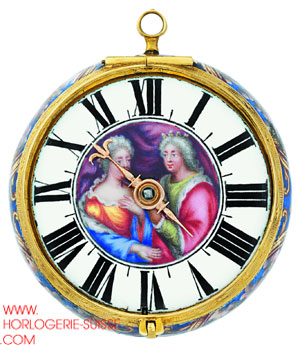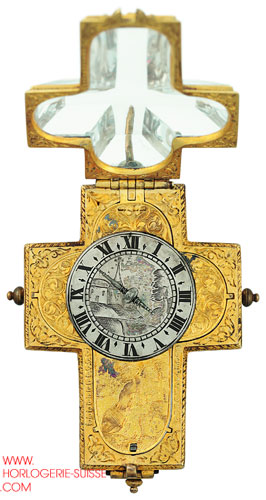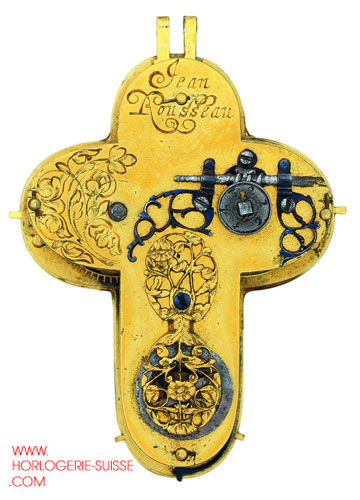

Horological news in brief
Patek Philippe Museum thematic exhibition: Timepieces signed Rousseau
From 11 May to 13 October 2012, the Patek Philippe Museum is hosting the Rousseau watchmaking dynasty
On the occasion of the three-hundredth anniversary celebrations of the birth of Jean- Jacques Rousseau organised by the City of Geneva and in the context of its “2012 Rousseau pour Tous” (Rousseau for All) programme, the Patek Philippe Museum and the Comité Européen Jean-Jacques Rousseau (CEJJR) present an exceptional exhibition. “Timepieces Signed Rousseau” is taking up residence at the Patek Philippe Museum from 11 May to 13 October 2012.
The exhibition showcases horological masterpieces from the 17th century: some thirty precious and rare timepieces from the collections of the Patek Philippe Museum, prominent museums and private collections. Constituting a vibrant tribute to the Rousseau watchmaking dynasty, they bear witness to the extraordinary manufacturing expertise of the Geneva Fabrique, an institution that from the 17th century onwards made the City of Calvin the cradle of fine watchmaking. Accompanied by a selection of archive documents, the watches on display invite visitors to discover a fascinating century where time won its spurs through the hand of man.
Under the name of the “Fabrique” were organised all of Geneva’s jewellery and watchmaking industries, in the form of independent workshops based on the apprenticeship system and grouped together in the Saint-Gervais neighbourhood. Transmitting their know-how from generation to generation, the master watchmakers and jewellers, along with the goldsmiths, enamellers, miniaturists, engravers, chasers and other artisans of the corporation, were zealous in pursuing and developing their métiers. Jean Rousseau, Jean-Jacques Rousseau's great-grandfather, belonged to this aristocracy of craftsmen. His seven sons followed in his footsteps, some as watchmakers, others as goldsmiths, engravers or lapidaries. Thus did the Rousseau dynasty occupy the horologically related trades.
Bottom : Charity
Round “bassine”-shaped watch
Painting on enamel on gold
Jean-Pierre Huaud (1655-1723) and Ami Huaud (1657-1724)
Berlin, circa 1690 / 1700
Movement with barrel, fusee, gear-train, verge escapement and balance spring
Rousseau (probably André, apprentice in 1664) Paris, circa 1700 Gold, enamel / gilt brass, steel
Movement signed: “Rousseau AParis”


From his youngest age, Jean-Jacques used to observe his grandfather David in his watchmaker’s atelier. It was there that he would realise the value of the craftsman's work. From this immersion into the precision of the act and of the mind, he developed a structural approach to thought as attested in this excerpt from Emile: “I am like a man who sees an opened watch for the first time and, although he did not know the use of the machine and had not seen the dial, should not cease to admire the result. I do not know, he would say, what all this is for, but I see that each piece is made for the others, I admire the craftsman in the detail of his work, and I am very sure that all these gears go thus in concert for a common end which I cannot perceive." (Book IV, OC p. 578)
Among the works shown here, more than twenty were signed by a member of the Rousseau family. Through the variety of shapes, decorations and mechanisms is revealed the astonishing freedom of creation of the 17th and 18th centuries. From memento mori to cross-shaped watches, coach watches to complicated timepieces, all are imbued with exceptional aesthetic and technical creativity. Here a miniature enamel painting embellishes a cover; over there, a finely chased decoration graces a case. Every detail crystallises the mastery deployed by the makers of time from past centuries. In the course of the exhibition, viewers can take a swath of history to heart through the saga of the Rousseau dynasty and immerse themselves in the Age of Enlightenment: the century that, beyond the realm of pure philosophy, consecrated the artisan as the emblem of reasoning with one’s hands.


Above : Cross Cross-shaped watch
Movement with barrel, fusee, gear-train and verge escapement
Jean (II) Rousseau (1606-1684) Geneva, circa 1630 / 1640 Silver, gilt brass, rock crystal / gilt brass, steel
Movement signed: “Jean / Rousseau”
Rousseau the philosopher, Rousseau the writer, Rousseau the politician, Rousseau the interdisciplinary sage… This man of greatness marked Western history and society for eternity. His convictions on liberty and intuitive conscience and on freedom of expression and thought, in addition to his analytical and contemplative sensibilities, have undeniably contributed to the aura of the city of Geneva.
The exhibition catalogue presents a collection of scientific and historical articles that provide a fresh perspective on the effervescent period of the 18th century. Highlighting the value of the Rousseau legacy, the authors portray a Geneva undergoing rapid expansion. A look at the Rousseau family tree reveals that Isaac Rousseau, the father of Jean-Jacques, worked as “watchmaker to the Sultan” on the banks of the Bosphorus. He studied the context of Calvin’s sumptuary laws of 1558 and the organisation of the famous Fabrique, and followed the aesthetic evolution of watches from their beginnings until the 18th century.
Opening hours:
Tuesday–Friday: 2 p.m.–6 p.m.
Saturday: 10 a.m.–6 p.m.
Closed Sunday–Monday and on legal holidays
Public guided tours every Saturday: from 2 p.m., every 30 minutes alternately in French and English. Groups up to 30.
Private guided tours available in 8 languages by appointment. Call 022 807 09 14 or email visit@patekmuseum.com
© 
toute reproduction strictement interdite
Tweet
Horological section in english